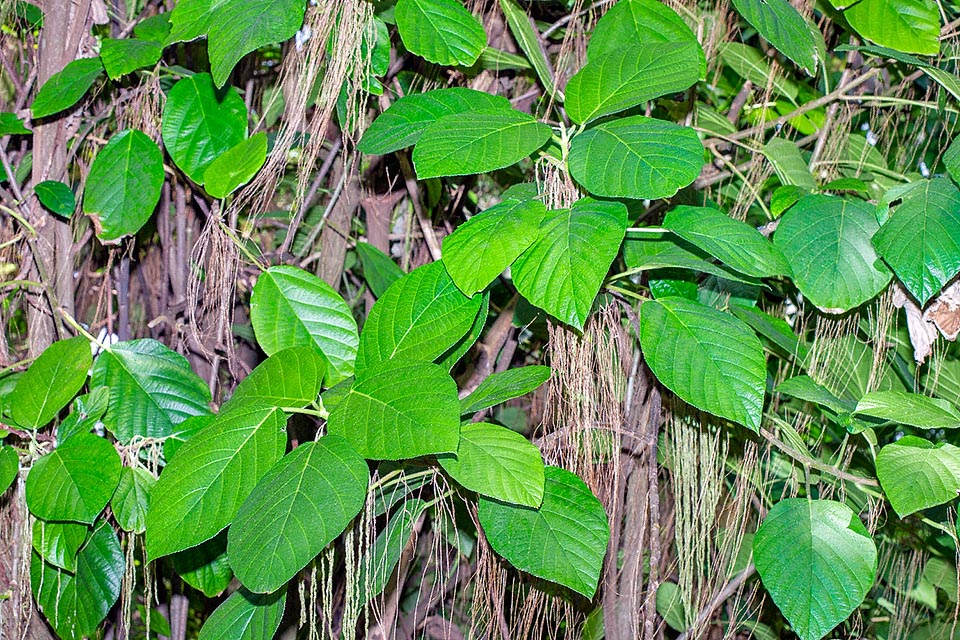Family : Urticaceae

Text © Pietro Puccio

English translation by Mario Beltramini
The species is native to Argentina, Belize, Bolivia, Brazil (Acre), Colombia, Costa Rica, Ecuador, El Salvador, Guatemala, Honduras, Mexico (Chiapas, Guerrero, Hidalgo, Michoacán, Oaxaca, Puebla, Querétaro, San Luis Potosí, Tabasco, Tamaulipas and Veracruz), Nicaragua, Panama, Peru and Venezuela where it lives in the under-wood or at the margins of the humid tropical forests, often close water streams, from the sea level up to about 2000 m of altitude.
The name of the genus is the combination of the Greek adjective “μυρίος” (myrios) = countless and of the substantive “καρπός” (carpόs) = fruit, with obvious reference; the name of the species is the combination of the Latin adjective “longus, a, um” = long and of the substantive “pes, pedis” = foot, stem, with reference to the long inflorescences.
Common names: cow itch (English); chichicastillo, mala mujer (Belize); estrella, ortiga (Costa Rica); chichicaste colorado, picapica (El Salvador); chichicaste, chichicaste manso (Guatemala); chichicastillo (Honduras); carne de caballo, chicastle, chiguapa, cholagogue indio, mal hombre, palo mulato, panza de burro, pechuga de gallina, puchalante (Mexico); chichicaste de montaña (Nicaragua).
The Myriocarpa longipes Liebm. (1851) is a shrub or a small evergreen tree usually dioecious, rarely monoecious, 1,5-6 m tall, with pubescent branches.

Odd relative to the nettles, Myriocarpa longipes is a shrub or a 1,5-6 m small tree. Native to tropical America, is at times cultivated for fences and for its medicinal virtues © Giuseppe Mazza
The leaves, on a 4-30 cm long petiole, are alternate, simple, ovate-elliptic with acute to acuminate apex, rounded to cuneate base, and crenate-toothed margin, 15-45 cm long and 7-26 cm broad, of dark green colour and glabrous or slightly bristly above, paler and slightly hairy below. Solitary unisexual inflorescences at the axil of the leaves, filiform, drooping, the females ramified close to the base, 20-100 cm long, with sessile flowers closely arranged on one side of the rachis, without corolla, but with two bracts at the base about 0,5 mm long. Male inflorescences, 5-25 cm long, with compact sessile flowers, of about 1,5 mm of diameter, with 4 tepals, of white, cream or greenish colour, and 4 stamens; the pollen is released in an explosive way. The fruits are ovoid achenia, about 1 mm long, of greenish colour.
Species with great leaves and odd long and thin drooping inflorescences, occasionally cultivated in the gardens for fences and for domestic and medicinal uses, but usually harvested directly in nature. The leaves are utilized by some populations to wrap the meat and in the traditional medicine, applied on the skin, as local painkiller in the rheumatic pains or of other nature; the plant is also employed in some countries for the malaria treatment.
Synonym: Myriocarpa inaequilateris Liebm. (1851); Myriocarpa longipes var. yzabalensis Donn. Sm. (1891); Myriocarpa magnifica Rusby (1920); Myriocarpa yzabalensis (Donn. Sm.) Killip (1937).
→ To appreciate the biodiversity within URTICACEAE family please click here.
